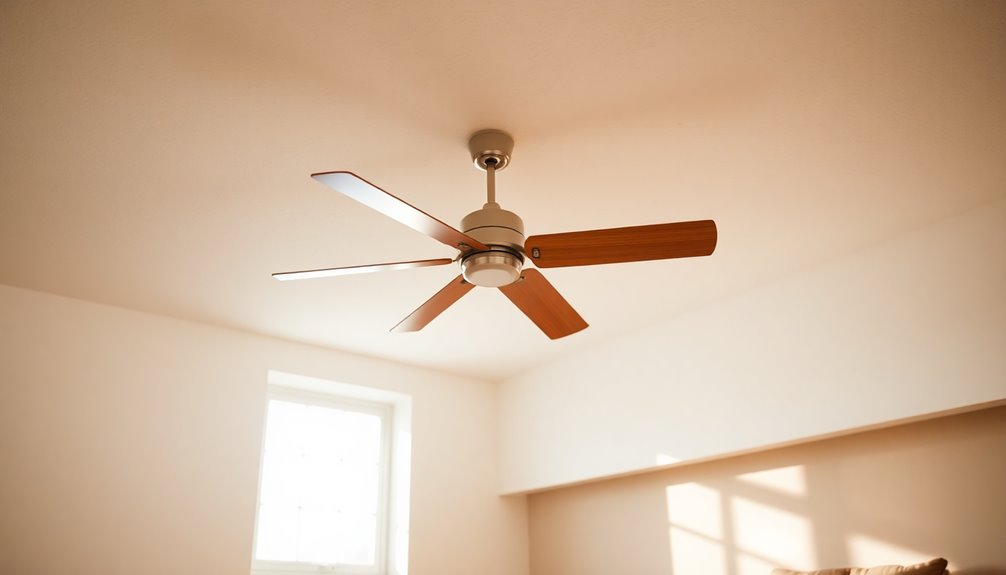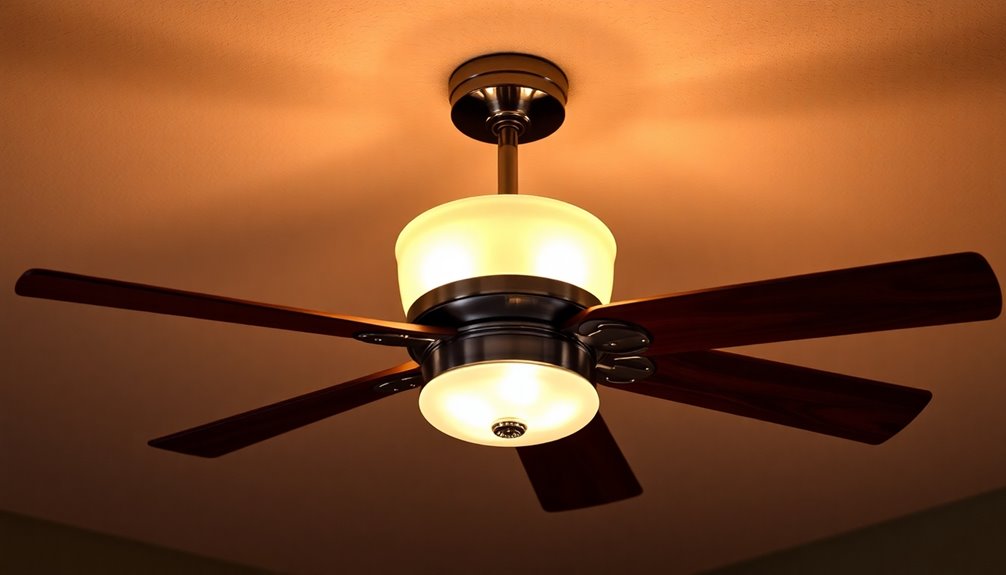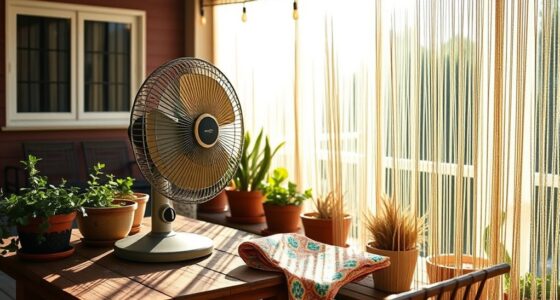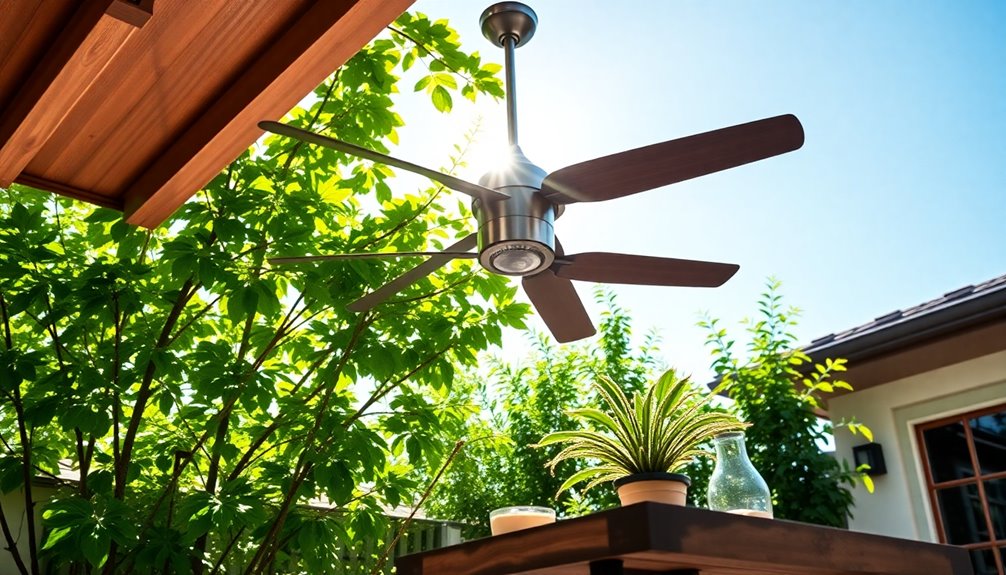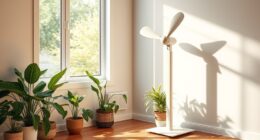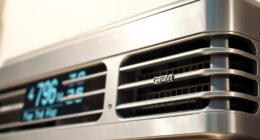Yes, the direction of your ceiling fan definitely matters. In summer, set it to rotate counterclockwise to create a cooling breeze, making your space feel up to 4 degrees cooler. In winter, switch it to clockwise to push warm air down and improve heating efficiency, helping reduce energy costs. Adjusting your fan's direction with seasonal changes is key to maintaining comfort and efficiency. Remember to make these adjustments at the start of spring and fall for best results. You'll discover even more tips and benefits on how to maximize your ceiling fan's effectiveness.
Key Takeaways
- Ceiling fan direction affects air circulation, influencing comfort and energy efficiency in both summer and winter.
- Counterclockwise rotation in summer enhances cooling, allowing higher thermostat settings without sacrificing comfort.
- Clockwise rotation in winter redistributes warm air, improving heating efficiency and potentially reducing heating costs by up to 15%.
- Regularly adjusting the fan direction with seasonal changes optimizes comfort and prevents stagnant air.
- Proper installation and maintenance of the fan ensure maximum airflow and efficiency, contributing to energy savings.
Importance of Ceiling Fan Direction

Understanding the importance of ceiling fan direction can greatly enhance your home's comfort and energy efficiency. The direction you choose impacts air circulation and temperature regulation, making a significant difference in how your space feels.
During winter, setting your ceiling fan to clockwise rotation redistributes warm air that rises, helping your heating system work more efficiently. This simple adjustment can reduce utility bills by 15% or more.
In summer, switch to counterclockwise rotation to create a cooling breeze, allowing you to raise the thermostat by up to 4 degrees. This can cut your energy costs by as much as 30%.
Seasonal adjustments are essential for maintaining consistent room temperatures and preventing stagnant air, optimizing your comfort throughout the year. Additionally, regular maintenance of your ceiling fan ensures it operates efficiently and safely, further enhancing your home's comfort.
Seasonal Direction Guidelines

Adjusting your ceiling fan's direction according to the season is key to maximizing comfort and energy efficiency in your home.
In summer mode, set your ceiling fan to rotate counterclockwise. This creates a downdraft, delivering an invigorating cooling breeze that enhances your comfort through evaporative cooling on your skin.
Conversely, switch to winter mode by changing the direction to clockwise. This will create an updraft, redistributing warm air trapped near the ceiling and helping maintain a consistent temperature throughout the room.
Here are some seasonal direction guidelines to keep in mind:
- In spring, switch to counterclockwise for summer cooling.
- In fall, change to clockwise for winter warmth.
- Proper fan size matters for ideal comfort; choose larger fans for larger spaces.
- Adjusting your fan can lead to energy savings—up to 4 degrees in summer and 15% in winter heating costs.
- Regularly changing the direction improves overall fan operation and efficiency.
Methods to Change Direction

How can you easily change the direction of your ceiling fan? First, always turn off the fan to guarantee safety during the adjustment process. Here are some common methods for changing direction:
| Method | Steps | Notes |
|---|---|---|
| Pull Chain Fans | Locate the ceiling fan switch on the body, slide it to the opposite direction, and turn it back on. | Changes direction between clockwise and counterclockwise. |
| Remote Controls | Turn off the fan, press and hold the fan button on the remote until the light blinks, then turn it back on. | Easy and convenient! |
| Smart Ceiling Fans | Use the SIMPLEconnect app or voice commands, guaranteeing the fan is off before making changes. | Offers modern convenience. |
Familiarize yourself with your specific fan model, as some may have unique methods or switches for changing direction, including wall control systems or light switch methods. Whether you want to change the ceiling fan for winter or summer use, understanding these methods will help you adjust the fan direction efficiently. Always prioritize safety by turning off the fan before making any adjustments!
Timing for Direction Adjustments

When it comes to ceiling fan direction, timing your adjustments can make a big difference in comfort and energy efficiency.
Changing your fan's direction at key points throughout the year guarantees you're maximizing airflow according to seasonal temperature changes. For example, set your fan to spin counterclockwise in spring and summer for cooling, while clockwise in fall and winter promotes warmth.
Here are some tips for effective timing adjustments:
- Monitor Daylight Savings Time: Use it as a reminder for seasonal direction changes.
- Align with Temperature Shifts: Adjust the fan direction as the weather changes.
- Consider Room Size: Confirm your fan size matches room dimensions for peak airflow.
- Stay Energy Efficient: Proper adjustments can help reduce your utility bills.
- Enhance Comfort: Correct directional changes enhance your overall comfort level.
Ceiling Fan Direction in Summer

In summer, you want your ceiling fan to rotate counterclockwise for ideal cooling.
This direction not only enhances air circulation but can also help you save on energy costs by allowing you to set your thermostat higher without sacrificing comfort.
Let's explore how adjusting your fan's direction can make a significant difference during those hot months.
Ideal Rotation for Cooling
Summer heat can make your living space uncomfortable, but adjusting your ceiling fan's rotation can considerably enhance your cooling experience.
During these warmer months, setting your ceiling fan to rotate counterclockwise is essential. This direction creates a downdraft, pushing cool air downward and maximizing the cooling effect. You'll benefit from the wind chill effect, making the temperature feel up to 4 degrees cooler.
To get the most out of your ceiling fan, keep these tips in mind:
- Use high speed for ideal airflow and comfort.
- Stand beneath the fan to confirm proper rotation; a strong breeze indicates it's spinning correctly.
- Regularly adjust the fan direction to maintain consistent air circulation.
- Consider the layout of your room to enhance cooling efficiency.
- Combine fan use with other cooling methods for ultimate comfort.
Energy Savings Potential
How can adjusting your ceiling fan's direction help you save on energy costs during the hotter months? By setting your ceiling fan to rotate counterclockwise, you create a downdraft that enhances the cooling effect through a wind chill sensation. This allows you to raise your thermostat by up to 4 degrees without sacrificing comfort, leading to significant energy savings.
Here's a quick look at the benefits of adjusting your fan direction:
| Benefit | Details |
|---|---|
| Cooling Effect | Counterclockwise rotation pushes air downwards, making the room feel cooler. |
| Energy Savings | You could save up to 30% on energy costs by reducing reliance on air conditioning. |
| Wind Chill Sensation | Running the fan at higher speeds amplifies the cooling effect even at higher temperatures. |
| Seasonal Needs | Regularly changing fan direction optimizes energy efficiency throughout the year. |
| Lower Utility Bills | Consistent adjustments contribute to diminished utility bills over time. |
Enhanced Air Circulation
Adjusting your ceiling fan's direction can greatly enhance air circulation during the warmer months. By setting your ceiling fan to rotate in a counterclockwise direction, you create a downdraft effect that pushes cool air downwards. This not only provides a revitalizing cooling breeze but also increases air movement, making your space feel considerably more comfortable.
You can even raise your thermostat settings by up to 4 degrees without sacrificing comfort.
Consider these benefits of using your ceiling fan correctly:
- Creates a cooling breeze that enhances comfort.
- Reduces energy costs by up to 30% when paired with air conditioning.
- Helps prevent warm air stagnation for consistent temperatures.
- Increases evaporation from your skin, enhancing the wind chill effect.
- Improves overall indoor comfort by maintaining airflow.
To guarantee ideal airflow, stand beneath the fan and feel for a steady breeze downward. Regularly adjusting to the counterclockwise direction not only promotes energy efficiency but also keeps your space feeling fresh and inviting during those hot summer days.
Embrace the enhanced air circulation for a more enjoyable home environment!
Ceiling Fan Direction in Winter

In winter, you should set your ceiling fan to rotate clockwise to push warm air down into your living space.
This simple adjustment can help you save on energy bills by improving heating efficiency without needing to raise your thermostat.
Plus, running the fan at a low speed prevents any cold drafts, keeping your home cozy.
Clockwise Rotation Benefits
When the winter chill sets in, using your ceiling fan in a clockwise direction can make a noticeable difference in your comfort. This clockwise rotation creates an updraft that helps circulate warm air that rises to the ceiling, redistributing heat throughout the room.
By running the fan at a low speed, you can prevent cold drafts while mixing warmer air with cooler air at lower levels.
Here are some key benefits of using your ceiling fan this way:
- Enhances comfort: Eliminates cold spots, ensuring a consistent temperature.
- Circulates warm air: Maximizes heat distribution for a cozy living environment.
- Increases energy efficiency: Works with heating systems to improve performance.
- Reduces utility bills: Enjoy potential savings of 15% or more without adjusting the thermostat.
- Easy verification: Stand beneath the fan to check that blades move rightward for proper clockwise rotation.
Energy Savings Potential
Using a ceiling fan in the winter can lead to significant energy savings. By adjusting the ceiling fan direction to clockwise, you create an updraft that pushes warm air down from the ceiling, distributing heat evenly. This simple adjustment can lower your thermostat settings, potentially reducing your heating costs by up to 15% or more.
| Benefits | Impact |
|---|---|
| Warm Air Distribution | Eliminates cold spots |
| Reduced Thermostat Settings | Saves on heating costs |
| Improved Comfort | Maintains a comfortable environment |
Running your fan at a low speed helps prevent cool drafts, ensuring a cozy atmosphere without chilling you. This enhances the overall efficiency of your heating system, offering better energy savings. By utilizing your ceiling fan during the winter, you can enjoy a consistent and pleasant indoor temperature while also being mindful of energy consumption. Adjusting your ceiling fan direction isn't just a minor detail; it's an effective strategy for creating a warmer, more comfortable home while cutting down on energy expenses.
Benefits of Correct Usage

How can you maximize comfort and savings in your home? The correct usage of your ceiling fan is key. Adjusting the ceiling fan direction according to the season enhances energy efficiency and maintains a pleasant atmosphere year-round.
Here are some benefits of using your ceiling fan correctly:
- Cooling Breeze in Summer: The counterclockwise rotation creates a revitalizing wind-chill effect, allowing you to raise your thermostat by up to 4 degrees.
- Warm Air Circulation in Winter: Running the fan clockwise at a low speed helps circulate warm air that rises, improving heating efficiency.
- Seasonal Adjustments: Regularly changing the direction based on the summer and winter seasons guarantees ideal air circulation.
- Consistent Room Temperature: Adjustments prevent stagnant air, maintaining a comfortable environment throughout your home.
- Energy Savings: You could save up to 30% on cooling costs in summer and 15% in winter with smart ceiling fan direction.
General Tips for Ceiling Fans

Maximizing your ceiling fan's effectiveness involves a few simple yet vital practices.
First, adjust your ceiling fan direction based on the season. During summer, set it to rotate counterclockwise to create a cooling breeze that helps reduce your reliance on air conditioning. In winter, switch it to clockwise to circulate warm air from your heating system, enhancing energy efficiency and preventing cool spots.
Proper installation is essential for ideal airflow. Make sure your fan is installed 7-9 feet from the floor and at least 18 inches away from walls. This positioning maximizes airflow and functionality, allowing you to enjoy greater comfort in your space.
Don't forget about maintenance! Regularly clean the blades and check for balance to keep your fan running smoothly. This simple practice not only prolongs the life of your fan but also boosts its energy efficiency.
Consider investing in smart ceiling fans that come with remote controls or apps. These innovative features make it easy to adjust the fan direction and speed, enhancing your indoor comfort with just a click.
Frequently Asked Questions
Does It Matter Which Direction a Ceiling Fan Turns?
Yes, it does matter which direction your ceiling fan turns.
When you set it to spin counterclockwise during summer, you'll feel a revitalizing breeze, helping you stay cool while lowering your thermostat settings.
In winter, switch to clockwise to circulate warm air that rises, making your space cozier and potentially saving on heating costs.
Regularly adjusting the direction based on the season maximizes comfort and energy efficiency, enhancing your overall living experience.
Does Reversing a Ceiling Fan Really Work?
Reversing a ceiling fan really works! When you switch the direction, you can create a cooling breeze in the summer or distribute warm air in the winter.
This simple adjustment can greatly improve your comfort and even lower your energy costs. Just remember to turn off the fan before making the change and keep the speed in mind—higher in summer for cooling and lower in winter to avoid drafts.
It's an easy way to enhance your space!
Why Does My Ceiling Fan Make My Room Hotter?
If your ceiling fan makes your room hotter, it could be set to the wrong direction. When it spins clockwise, it creates an updraft that traps warm air, making you feel uncomfortable.
Also, dust on the blades can hinder airflow, forcing the fan to work harder and generate more heat.
To improve comfort, check the fan direction and clean the blades regularly. This way, you'll guarantee effective air circulation and a cooler environment.
What Happens if a Ceiling Fan Rotates in Opposite Direction?
If your ceiling fan rotates in the opposite direction, you'll notice it doesn't cool or heat your room effectively.
Instead of circulating air properly, it might create drafts or leave warm air trapped near the ceiling. This can lead to discomfort and higher energy bills, as you may rely more on your HVAC system.
To keep your space comfortable, adjust your fan's direction seasonally, ensuring ideal airflow for your needs.
Conclusion
So, if you think ceiling fan direction doesn't matter, just remember: you might as well wear your winter coat in July or sip hot cocoa in the sweltering heat! By simply flipping that switch, you can either enjoy a rejuvenating breeze in summer or cozy warmth in winter. Who wouldn't want to feel like a genius for mastering the art of ceiling fan direction? Embrace your newfound power and let those blades work for you—after all, it's only your comfort at stake!
